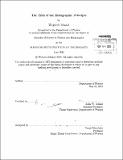The trial of the holographic principle
Author(s)
Musiał, Wojciech, S.B. Massachusetts Institute of Technology
DownloadFull printable version (2.656Mb)
Other Contributors
Massachusetts Institute of Technology. Department of Physics.
Advisor
Allan W. Adams.
Terms of use
Metadata
Show full item recordAbstract
We present an introduction to ideas related to the holographic principle in the context of the well-established duality between classical gravity and conformal fluid dynamics. Foundations of relativistic hydrodynamics, conformal invariance, and geometry of anti-de Sitter spaces are discussed. We then detail an explicit calculation relating the dynamics of a non-stationary nonsymmetrical 3+1 dimensional black hole on an anti-de Sitter background to the dynamics of a 2+1 conformal fluid. The correspondence is established in a perturbative series expansion of the black hole metric, corresponding to a hydrodynamical expansion of the stress-energy tensor of the dual fluid. The stress-energy tensor of the dual fluid, whose conservation arises as a consequence of Einstein field equations of the dual black hole, is calculated via the Brown-York prescription augmented with renormalization of divergences. While the fluid-gravity idea is well-established, our careful analytic computation finds a form of the metric computed at second order in the gradient expansion that differs in some respects from results in previous literature. We finally report results of our work to realize the fluid-gravity duality numerically. We have solved 2nd order hydrodynamic flow numerically and attempted to construct the black hole metric dual to the flow. Investigation of power law scaling of the Einstein tensor indicates success at 0th and 1st, but not the 2nd order. We have also observed in a low-resolution simulation that the hydrodynamic flow supports turbulence, which prompts the question of the interpretation of dual turbulent behavior of the black hole geometry.
Description
Thesis (S.B.)--Massachusetts Institute of Technology, Dept. of Physics, 2013. Cataloged from PDF version of thesis. Includes bibliographical references (pages 45-46).
Date issued
2013Department
Massachusetts Institute of Technology. Department of PhysicsPublisher
Massachusetts Institute of Technology
Keywords
Physics.